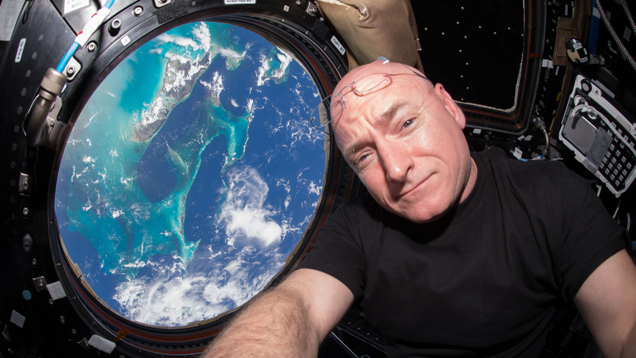Scientific Adventures: Shrimp-like creatures nervous system preserved in 520 million year old fossil
 CREDIT: "ISS044E011632" BY NASA JOHNSON ON FLICKR (CC BY-NC 2.0)
CREDIT: "ISS044E011632" BY NASA JOHNSON ON FLICKR (CC BY-NC 2.0)Astronaut Scott Kelly grew in height after returning from a 340-day stay on the International Space Station.
One-year mission astronaut and cosmonaut return home
Astronaut Scott Kelly and cosmonaut Mikhail Kornienko returned from their 340-day stay on the International Space Station (ISS) as part of the one-year mission. Run by NASA in conjunction with Russia’s Federal Space Agency (Roscosmos), the mission was the latest in a series of tests to begin figuring out how to send humans to Mars within the next 30 years.
The pair, along with cosmonaut Sergei Volkov landed in the desert region Kazakhstan on March 2, after taking three hours to deorbit from the ISS.
The one-year mission was unique in that everything that happened to Kelly in space could be measured more accurately, due to him having a twin back on Earth.
Back on Earth, Mark Kelly, Scott’s twin, acted as a control set for everything happening to his brother while orbiting Earth.
One of the more noticeable changes to Kelly’s physical state was his height. The astronaut gained about five centimeters, though not unexpected by NASA scientists.
The process, called spinal decompression, happens when the discs between the back’s vertebrae begin expanding. This happens due to the lack of gravity pushing the body’s weight down onto the intervertebral discs, flexible cushions of tissue between each bone in the spine.
Immediately back on Earth, the two experimentees were made to perform tasks that would be similar to what explorers on Mars would need to potentially perform immediately after landing.
In a recent YouTube video, ISS chief scientist, Dr. Julie Robinson, stated that during the year-long mission, Kelly had already undergone about 340 medical tests and experiments, and that more tests such as measuring bone density and transformation will take up to three years to complete.
While the duos’ stay in orbit was the longest in almost 10 years, it isn’t the longest a human has stayed in space at one time, or even altogether. Cosmonaut Valeri Polyakov stayed in space for almost 438 days aboard the Mir Space Station back in 1995, while cosmonaut Gennady Padalka, who coincidentally launched with Kelly and Kornienko on Expedition 43 on March 28, 2015, holds the record for the most cumulative time in space, orbiting earth 879 days.
Oldest, most complete nervous system fossil found in China
Researchers from China, Germany and U.K. have discovered and imaged a fossil containing the most complete nervous system ever found, dating the find at 520 million years old.
The Cambrian Period fossil contains the body of the roughly four-centimetre long Chengjiangocaris kunmingensis, a shrimp-like creature of the fuxhianhuiids order, which were precursors to arthropods.
The Cambrian Explosion as it’s more commonly known, happened 517 to 542 million years ago, when life on Earth’s biodiversity rapidly changed, from primarily simple single- celled organisms to a range of multicellular creatures.
Among those most successful even to this day are arthropods, making up a vast selection of life on Earth, about 80 per cent of all creatures, from bees and spiders to barnacles and lobsters.
Original research finding the fossils was published in 2013, with the authors then stating their intentions to further research one of the specimens that was believed to have a preserved nervous system.
Precise rock chipping with a needle- like hammer led to the discovery that an almost complete fossil of Chengjiangocaris’ nervous system had become fossilized.
Even individual nerve fibres measuring only five thousandths of a millimetre were preserved, a ground-breaking amount of detail for a fossil of any time period.
As mentioned in the Cambridge University press release, previous discoveries of arthropod soft tissue fossils were the brains of similar creatures, which have been found to be more easily preserved in the fossil record.
Vertebrates, which includes species like humans and sharks, have a central nervous system where the brain attaches to a spinal column, which then attaches to nerves.
Arthropods are similar in that they have a brain and spinal column- like structure called a nerve cord, they also have bulges along the column that act as mini brains called ganglia, each controlling a specific aspect, like a single pair of legs or sensory hairs.
The fossil not only showed all of these features in pristine detail, but also revealed another sensory structure not currently found in any species today.
The researchers also found that the level of complexity of the fossil nervous system was greater than that of more advanced arthropods currently observed, which the researchers proposed a simplification of the nervous structure led to the evolution of more advanced systems today.
While fossils are technically any biological remains preserved by time in rock, it’s usually quite rare for a fossil to contain soft tissue of organisms, due to the fat cells of a creature being destroyed easily before it has the chance to begin the fossilization process.
The find is important for arthropods because it allows evolutionary scientists a peek at an ancient nervous systems and how they might have evolved into structures seen in modern species today.
Next week we’ll look at how amber is allowing scientists to view tiny lizards from over 100 million years ago.














